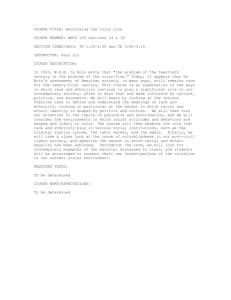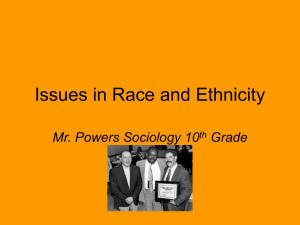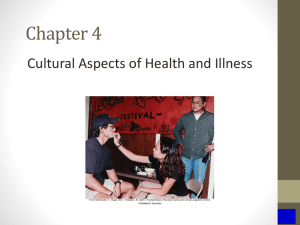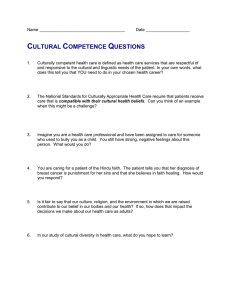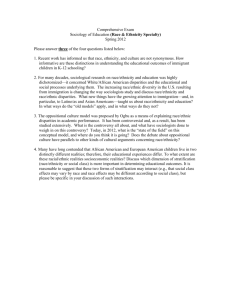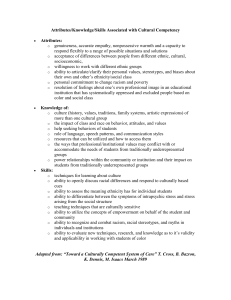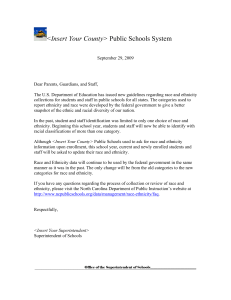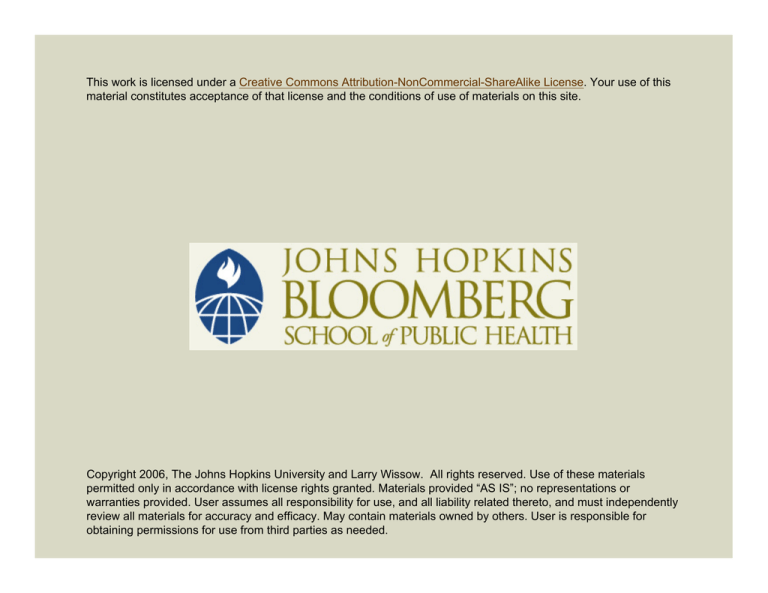
This work is licensed under a Creative Commons Attribution-NonCommercial-ShareAlike License. Your use of this
material constitutes acceptance of that license and the conditions of use of materials on this site.
Copyright 2006, The Johns Hopkins University and Larry Wissow. All rights reserved. Use of these materials
permitted only in accordance with license rights granted. Materials provided “AS IS”; no representations or
warranties provided. User assumes all responsibility for use, and all liability related thereto, and must independently
review all materials for accuracy and efficacy. May contain materials owned by others. User is responsible for
obtaining permissions for use from third parties as needed.
Race and Racial
Disparities in Health and
Health Care
Larry Wissow
Professor
Health, Behavior and Society
Johns Hopkins School of Public Health
Main “take-home” points
“Race” has become a meaningful but
meaningless term
Might we consider it a self-perpetuating social
construction?
It is meaningful as a social construction
because of its relationship to health status
and health services
Definitions
Race: original definition – “shared biologic
origin”
Considered “self-evident” in European scientific
tradition, a “natural fact” that there was a hierarchy
of types of humans endowed with different
strengths and weaknesses
Highly resistant idea, despite increasing proof that
it has little basis in human genetics
Definitions
Ethnicity: label given to a group of people with a
shared language, history, and national origin
Ethnicity: label given to a group of people with a
shared “culture” (set of shared beliefs,
attitudes, values, behaviors)
History of racial classification
in the US (Nobles)
1790-1840
Constitution mandated a census to assure equal
representation in new government
Enumeration based on status as free or slave and whether
paid taxes
Categories
Free white males and females
Anyone else who was free regardless of color
Slaves
Indians
Who counted in 1790
All free persons = 1
Slaves = 3/5 person
Indians = 0 (not taxed)
Why the distinction between white and notwhite free (though counted the same)
Nobles: “natural fact” ?; otherwise not clear
Scientific era – 1850-1920
Theory of “polygenism”
Races distinct and unequal, separate origins
Mixtures would be unfertile, unfit
“Lesser” races dominant and mixtures would
eventually “revert” to them over generations
[see movie: “Rabbit-proof Fence”]
Scientific era – 1850-1920
Pressure to use Census to investigate
polygenetic hypotheses
First developed “mulatto” (any perceptible trace of
African blood)
Later expanded to “quadroon,” “octroon” to further
estimate amount and type of mixture
US Indians now counted to measure
disappearance (thought to be proof of their
inferiority)
1930-1960
Social changes
Beginnings of Civil Rights movement
Nazi atrocities committed in name of race
Scientific advances
Data from cultural anthropology
Findings of some important but relatively minor
biologic differences
1930-1960
Classifications “simplified”
White [not defined, anything not something else]
Non-white [includes obvious “other” and any
mixture of “other” and white
So distinction still hangs on
Civil Rights Era 1970 +
Civil Rights Act of 1964, Voting Rights Act of
1965 make segregation and discrimination
illegal
But now need to measure “race” to ensure
enforcement
‘Hispanic’ added as an “ethnicity” (not “race”)
‘White’ still seen as homogeneous entity
“Asian” categories expanded
Degree of variation among
populations
Variants present in one population are generally present but not
necessarily common in other populations
Geographic ancestry and knowledge of genetic diversity in that
specific region of the world related to genetic risks
Relationship of “race” to geographic ancestry varies
So maybe “biogeographic ancestry” is a more useful way of
gauging possible clinical/public health significance in risks and
protective factors
What forces perpetuate
“race”?
Attempt to identify populations at risk of being
harmed by social norms (among the
powerful) that we wish to change
Desire to count those eligible for special benefits
or compensation
Desire to measure compliance with laws aimed at
changing social norms
American Indian tribes
In US law varies by program/issue
Eligibility for social programs
Jurisdiction in criminal matters
Preferences in government hiring
Administration of tribal property
Can be divisive among Indians
Not all tribes “recognized” by government (ie, seen as having
political/economic relationship with federal government
American Indian tribes
Definitions have at least two perspectives
Cohen (in Rhoades p63): person who:
1. Has some ancestors who lived in “America” prior to its
“discovery” by Europeans, and
2. Recognized as an Indian by his or her tribe or
community
Tribes have economic and cultural
motivations to define membership
Motivations to develop a racial
identity (racial socialization)
Point around which to build a community
Pride, sense of collective duty, mechanism for
preserving cultural attributes
Alternative to political definitions if needed
Means of excluding those seen as who seek
to “crash” and obtain scarce resources
Means of advocating for access to services
Preparation for bias
Adverse sides of racial
socialization?
Vicarious traumatization from collective
experiences of discrimination
Negative expectations about opportunities
Self-fulfilling influence on cross-cultural
interactions
Others?
So why do we use “race” as a
variable in public health?
Possibly appropriate
Experience or practice of discrimination is a
relevant variable
Studies of populations that self-identify in this way
Studies linked to policies/laws that use this label
Studies of the legitimacy of using the label
Why use “race” as a variable?
Probably not appropriate
Conscious or unconscious proxy for income, SES,
place of residency
Studies that assume race has inherent biologic
associations to broad characteristics like behavior
or intelligence
Why use “race” as a variable?
??
Studies targeting populations with apparent
differences in gene prevalence
Tay-Sachs (Eastern European Jews)
Sickle cell disease (African-Americans)
Cystic Fibrosis (Caucasians)
Liver enzyme polymorphisms (various)
Associations likely to change with geographic
mobility
Racial disparities in health in
the US
US African-Americans have higher rates than
Whites for 13 of 15 leading causes of death
Life expectancy at birth
Female AA: 74.7; White 79.9
Male AA 67.2; White 74.3
Accounting for poverty reduces some but not
all differences
Questions about disparities
Cultural differences in interaction, definitions of
health and illness?
Prejudicial attitudes on the part of care-givers?
Consumers' avoidant behavior based on fear
of discriminatory treatment
Questions about disparities
Lack of access to services and health-related
resources (including education)?
Increased exposure to health risk factors in
immediate environment?
Concern about provider
behavior
Kidney transplant
Blacks less likely to be offered option
Pain management
Whites more likely than Black, Hispanic to be
assessed and offered medication
Mental health
“Non-whites” more likely to be considered
psychotic, hospitalized involuntarily, placed in
seclusion
Concern about providers
Child welfare
Black youth more likely to be sent to juvenile justice
system versus mental health
Black children more likely to be reported as
suspected victims of abuse
Asthma
Blacks less likely to be prescribed preventive
medication
Explanations?
Overt prejudice and racism?
Unconscious bias and stereotypes?
Cross-cultural misunderstanding and
miscommunication?
All of the above?
Bias/stereotypes
Disparities mirrored in analysis of hypothetical
cases
Identical except for patient race
African-Americans more likely to be considered
non-adherent to treatment
African-Americans seen as lacking social support
for arduous treatments
Poor cross-cultural
communication skills
Failure to explain medical terms
Failure to probe ambiguous words
Failure to follow-up on patient cues
Inability/unwillingness to probe for alternative
explanatory models or other attitudinal or
emotional issues
Should patient and provider
be matched on race?
Physician ethnicity is associated with patients’
comfort discussing sensitive psychosocial
and emotional problems.
Patients from ethnic minority groups, in
general, report difficulty communicating with
doctors of a different ethnicity.
Are all matches “good?”
Ethnic mismatch alone may not predict
communication difficulty
African-American patients rate African-American
doctors as more participatory that White (CooperPatrick 1999)
Asian GP’s under-detect distress in Asian patients,
compared to White GP’s (Odell 1997)
Differences in doctor behavior
at first visits
Doctors were more patient-centered when
their ethnicity matched that of the mother
(pediatric residents)
MD patientcenteredness
MD and parent
ethnicity are
different
(reference value)
MD and parent
ethnicity match
(change with
matching)
249 utterances
per visit
71 (6 - 136)
Ethnic differences in first visits
African-American mothers made fewer
psychosocial utterances
average of 80/visit compared to 101/visit by
white mothers (average difference 21.2
utterances, 95% confidence limits 1.6 to
40.8).
Parent information-giving as a function of visit number,
adjusted for patient-centeredness, by doctor gender and
parent ethnicity
Predicted infopsyp
100
95
m ale A fam
90
fem ale A fam
fem ale non-A fam
85
80
75
70
65
v is itno
60
1
2
3
4
5
6
7
8
9
10
11
12
S c atter plot of predic ted infops y p (ptc entr= 250, ghqtot= 0)
¿Conclusions?
“Race Matters” (Cornell West)
A pseudo-scientific term has taken on political,
social, cultural meaning
We probably use racial labels too casually
Racial attitudes, like cultural beliefs, are
probably “overlearned” and therefore likely to
be unconsciously used as a basis of action

